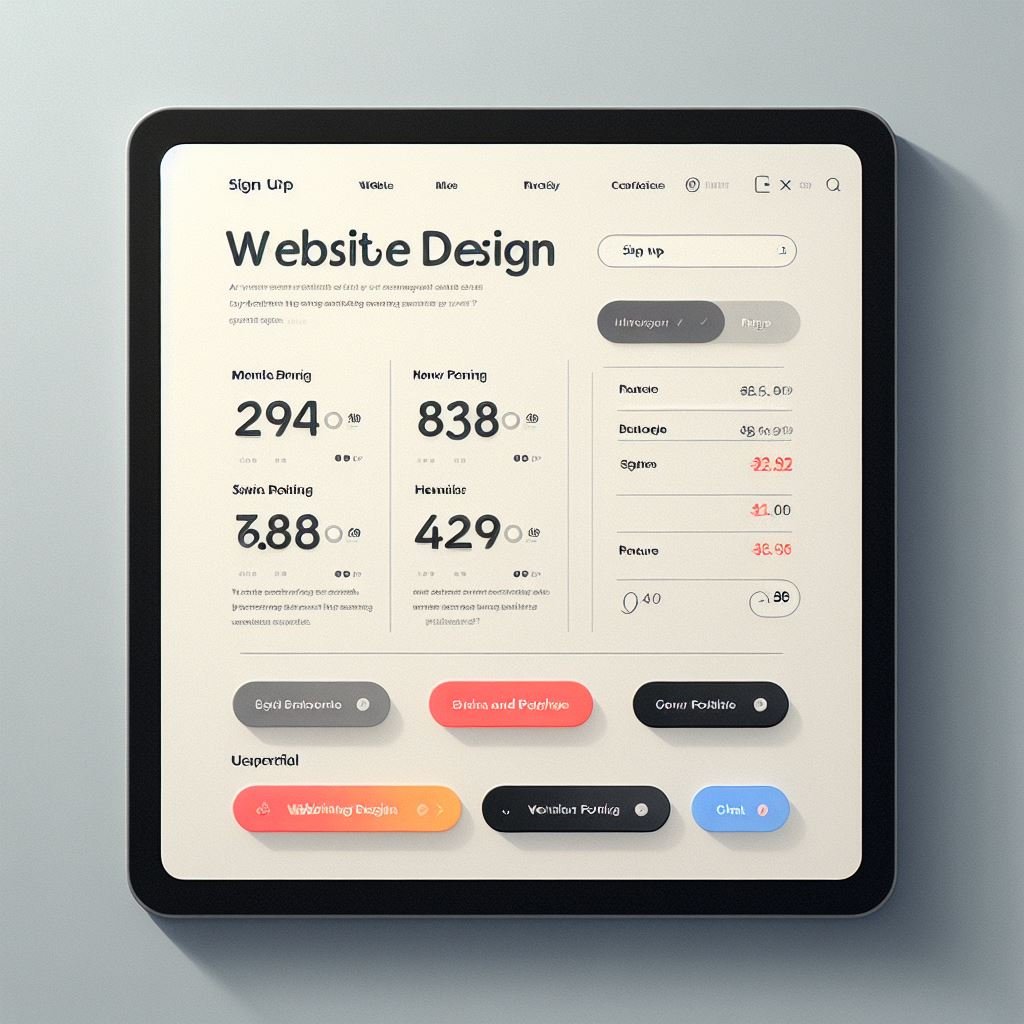Exploring Different Models for Website Design Pricing
In the fast-paced digital era, a website is often the first point of contact between a business and its audience. As businesses recognize the crucial role of an online presence, the demand for professional website design services is soaring. However, understanding the pricing models associated with website design is essential for both businesses seeking Website designers and services aiming to set fair and competitive rates. In this comprehensive guide, we delve into the various models that determine the price tag of success in website design.
Understanding the Landscape of Website Design Pricing
Hourly Rate Model:
One of the most common pricing models in the website design industry is the hourly rate model. Designers charge clients based on the number of hours spent on a project. This model is straightforward and provides a clear correlation between time invested and compensation received. However, clients may be concerned about potential project overruns, leading to higher costs.
Generally, website design hourly rates can range from $50 to $150 or more. Here’s a breakdown based on experience levels:
Entry-Level Designers:
Rates for entry-level designers or freelancers with limited experience may range from $50 to $75 per hour.
Mid-Level Designers:
Mid-level designers with a moderate level of experience typically charge between $75 and $100 per hour.
Experienced/Expert Designers:
Designers with extensive experience or specialized skills may charge $100 to $150 or more per hour.
Project-Based Model:
In the project-based model, website designers agree on a fixed price for the entire project, regardless of the time spent. This approach offers clients predictability in terms of cost, making budgeting more manageable. However, it requires accurate project scope definition to avoid misunderstandings and scope creep.
- Simple Websites:
Basic informational websites with a few pages and standard features may have project-based costs ranging from $1,000 to $5,000.
- Small to Medium Business Websites:
Websites for small to medium-sized businesses with additional features such as contact forms, image galleries, and basic e-commerce functionality could range from $5,000 to $15,000.
- E-commerce Websites:
Websites with more extensive e-commerce functionality, including secure payment gateways, product listings, and inventory management, may start around $10,000 and go up significantly based on complexity.

- Custom or Enterprise-Level Websites:
Custom websites designed for larger enterprises with complex requirements, unique features, and extensive customization can have project costs exceeding $20,000 and potentially reach six figures.
Value-Based Pricing:
Value-based pricing focuses on the perceived value of the website to the client’s business. Instead of basing the price on time or effort, designers consider the impact the website will have on the client’s goals. This model encourages a collaborative approach, aligning the designer’s success with the client’s business success.
Here are some considerations that can influence the cost of a value-based website design:
Business Goals:
The alignment of the website with the client’s overarching business goals plays a crucial role. If the website is perceived as a critical tool for achieving significant business objectives, the value and, consequently, the cost may increase.
Expected Impact:
The expected impact of the website on the client’s business is a key factor. If the design is anticipated to significantly enhance brand visibility, customer engagement, or revenue generation, it may command a higher value-based price.
Industry and Competition:
The industry in which the client operates and the competitive landscape can influence the perceived value of the website. Designs that provide a competitive edge or address specific industry challenges may be priced higher.
Customization and Innovation:
The degree of customization and innovation required in the design also affects the cost. Unique features, cutting-edge design elements, and innovative solutions contribute to the perceived value and may result in higher pricing.
Client’s Budget:
The client’s budget and willingness to invest in a high-value website design are important considerations. Value-based pricing often involves a collaborative discussion between the client and the designer to align expectations.
Factors Influencing Website Design Pricing
Complexity of the Project:
Complex websites with intricate functionalities, custom features, and advanced design elements naturally require more time and expertise. Designers often factor in the complexity of a project when determining pricing.
Scope of Work:
Clearly defining the scope of work is crucial in any pricing model. A well-defined scope helps prevent misunderstandings and ensures that both parties are on the same page regarding the project’s deliverables.
Customization and Unique Features:
Websites with unique features and a high level of customization usually incur higher costs. Whether it’s bespoke graphics, intricate animations, or specific functionality requirements, customization contributes to the overall pricing.
Responsive Design:
With the prevalence of mobile devices, responsive design is non-negotiable. Ensuring a seamless user experience across various devices adds complexity to the design process and may impact pricing.
E-commerce Functionality:
For businesses looking to sell products or services online, integrating e-commerce functionality is a significant factor in website design pricing. Secure payment gateways, inventory management, and product presentation all contribute to the complexity and cost.
Content Management Systems (CMS):
The choice of a CMS can influence pricing. Customizing and working with specific CMS platforms may require additional effort, affecting the overall project cost.
Exploring Website Design Pricing Models in Detail
- Hourly Rate Model: The Time-Tested Approach
Pros:
– Transparent correlation between time spent and compensation received.
– Allows for flexibility in project adjustments as needed.
Cons:
– Clients may be concerned about potential project overruns.
– Doesn’t align compensation with the value delivered.
The hourly rate model is a classic approach that provides clarity in terms of how designers bill their time. It allows for flexibility, especially when projects evolve or require adjustments. However, transparency can be a double-edged sword, as clients may worry about escalating costs.
- Project-Based Model: Fixed Costs for Predictability
Pros:
– Offers predictability for clients with a fixed project cost.
– Encourages efficiency and project completion within budget.
Cons:
– Requires precise project scope definition to avoid disputes.
– May not account for additional client requests outside the initial scope.
The project-based model provides clients with a fixed cost for the entire project, fostering predictability and easier budgeting. However, its success hinges on a meticulously defined project scope to prevent scope creep and disagreements over additional work.
- Value-Based Pricing: Aligning Success Metrics
Pros:
– Aligns the designer’s success with the client’s business success.
– Encourages collaboration and a focus on the website’s impact.
Cons:
– Requires a deep understanding of the client’s business goals.
– Can be challenging to quantify the value of design in monetary terms.
Value-based pricing is centered around the impact a website has on the client’s business goals. It encourages a collaborative approach and a focus on achieving measurable results. However, accurately quantifying the value of design in monetary terms can be a complex task.
The Role of Cross-Platform Frameworks
In the context of website design, the choice of a development framework can influence pricing. Cross-platform frameworks, such as React and Angular, offer the advantage of building responsive websites that work seamlessly across various devices. While these frameworks may require a learning curve, they can enhance efficiency and reduce development time, potentially affecting the overall project cost.

FAQs About Website Design Pricing
Why does website design pricing vary so much?
Website design pricing is influenced by various factors, including the complexity of the project, the scope of work, customization requirements, and the choice of features. Each project is unique, and designers tailor their pricing to reflect the specific needs and goals of the client.
How can I ensure transparency in website design pricing?
To ensure transparency, it’s essential to have a clear and detailed discussion with the designer about the scope of work, project requirements, and any potential additional costs. A written agreement or contract outlining these details can help prevent misunderstandings.
Can I negotiate website design pricing?
While some aspects of pricing may be negotiable, it’s crucial to recognize the value that a skilled designer brings to the project. Negotiating a fair price that reflects the complexity and requirements of the project is key to building a positive and collaborative relationship.
Are there ongoing costs after the website is designed?
Yes, there can be ongoing costs, such as domain registration, hosting fees, and maintenance. It’s essential to discuss these aspects with the designer and establish a clear understanding of any post-launch responsibilities and costs.
How do I choose the right pricing model for my project?
Choosing the right pricing model depends on factors such as project complexity, budget constraints, and the client’s preferences. Discussing these aspects with the designer and understanding the nuances of each pricing model can help in making an informed decision.
Conclusion
In the diverse landscape of website design pricing, understanding the various models is crucial for both clients and designers. Whether opting for an hourly rate, project-based approach, or value-based pricing, the goal is to establish a fair and transparent arrangement that aligns the success of the website designer with the success of the client’s online presence.
As technology evolves and businesses continue to embrace the digital realm, the conversation around website design pricing will likely evolve as well. By staying informed and open to collaboration, both clients and designers can navigate the intricate terrain of website design pricing and set the stage for successful

